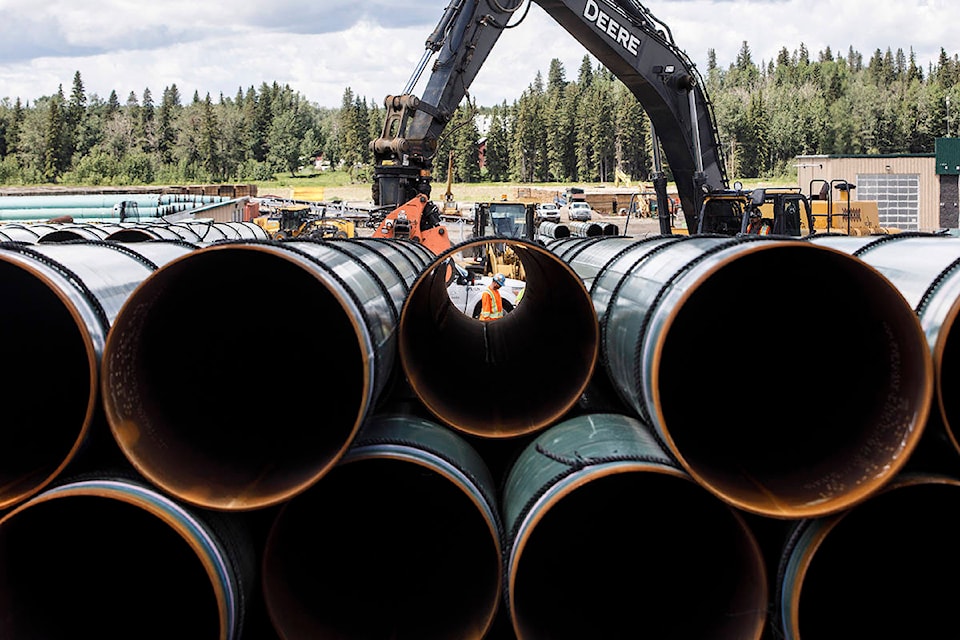First Nations bands and a Métis settlement from as far as northeastern B.C. want a say in a $500-million West Country natural gas pipeline project.
Ensuring the environment is protected in their traditional territories was a frequent theme in their applications.
Kelly Lake Métis Settlement Society - Apetkosan Nation, based about 100 km south of Dawson Creek, B.C. has joined half a dozen First Nations who have signalled they want to be intervenors or commenters in a public hearing for Nova Gas Transmission Ltd.’s plans to build 40- and 45-kilometre sections of pipeline to improve its capacity in central Alberta.
Nova hopes to have the $509-million project done by 2022.
Those with an interest in the project have until the end of Friday to apply as a participant or as an intervenor. As of Thursday, Samson Creek Nation, from Maskwacis; the Blood Tribe and Pikani Nation, south of Calgary; Alexis Nakota Sioux Nation, Paul First Nation and Papachase Cree Nation, of the Edmonton area, have applied to be part of the yet-unscheduled hearing.
A Sunchild First Nation representative said on Thursday the band northwest of Rocky Mountain House hopes to apply as well.
Natural Resources Canada and about half a dozen energy companies have also served notice they want to participate in the National Energy Board hearing.
Sunchild band Coun. Clint McHugh said the project and the up to 1,500 jobs Nova estimates could be created would be good news for band members and all Albertans.
“That’s good stuff for everybody,” said McHugh. “We have been in a big slump (in Alberta). Everybody needs the work.”
In their applications, First Nations bands focused on the importance of addressing the potential environmental impacts of the project.
Alexis Nakota Sioux Nation says construction and operation of the pipeline, its location and infrastructure and possible pipeline spills or malfunctions “have the potential to directly and adversely affect Alexis’s ability to exercise their rights and use their traditional resources, which have been relied upon for generations in the vicinity of the project.”
The Alexis Elk River Reserve is located about 40 km from one of the proposed pipeline sections, which are within the band’s traditional territory, which extends from Edmonton to the Rocky Mountains, and from Drayton Valley in the south to Swan Hills in the north.
“Alexis has relevant information and expertise that will improve the board’s understanding of the project’s potential impacts,” its application states.
Samson Cree Nation (SCN) says the ability to practise their Treaty rights “relies on sufficient quantity and quality of resources, including fish, culturally important plants, access, language, spiritual sites, cultural landscapes and the transmission of knowledge.
“The meaningful practice of SCN’s Treaty rights does occur within the project footprint and area,” says the band, which says it would like to have meaningful conversations and incorporate our input to “minimize impacts to our constitutionally protected rights.”
Kelly Lake Métis Settlement Society says that “any project that travels through our traditional territory needs to have our involvement. We are always concerned about the environmental impact.”
The group also wants qualified people from their settlement considered for pipeline jobs.
In its project description, Nova says it identified 20 First Nations bands and three Métis organizations potentially affected by the project and sent them information on the project and engaged in consultation, which is ongoing.
An environmental and socio-economic assessment was undertaken as part of the company’s application. It looked at everything from the impact on wildlife, wetlands and aquatic life to human health, social and cultural well-being and economics.
After mitigation measures are undertaken, any adverse effects on biophysical or socio-economic factors are “predicted to be not significant,” concluded Stantec.
pcowley@reddeeradvocate.com
Like us on Facebook and follow us on Twitter
